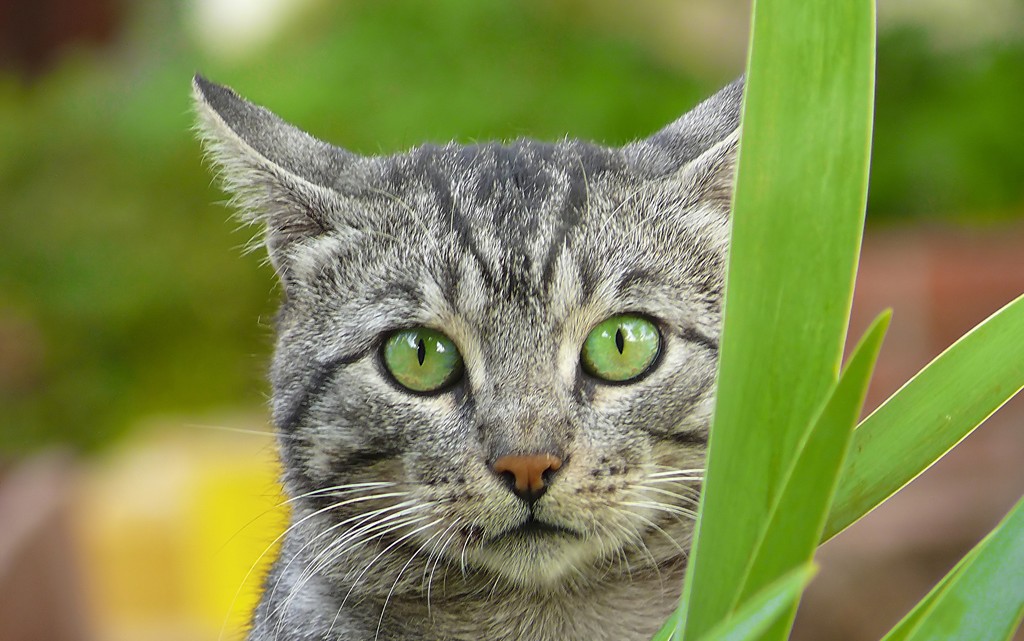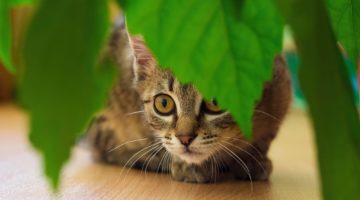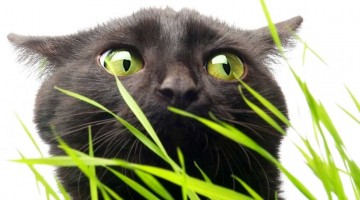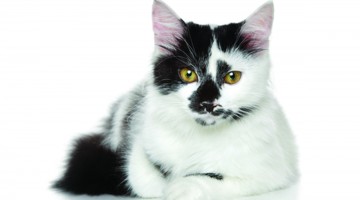Is he chewing your begonias or using your palm planter as a litter box? By taking some precautions, you don’t have to choose between your kitty and your prized houseplants.
Christine Derr’s two cats, Mel and Ollie, were showing an interest in one of their houseplants. When Mel found the plant on the refrigerator by way of the “forbidden” kitchen counter, Christine tried another location and gave Mel time to lose interest.
“I placed the plant on top of a six-foot bookcase for about two weeks,” she says. “Then, for the next few months, I lowered it to a bar-height chair tucked in the corner with no landing space around it. Now it sits on the same shelf with the cat food bowls, but they don’t seem to pay any attention to it.”
While their affection for houseplants has passed, Christine’s feline duo still feasts on fresh cut flowers. “On more than one occasion, I’ve awakened to find a vase of flowers tipped over and some leafy cat yak on my carpet.”
Many Plants are Poisonous
A lot of houseplants and cut flowers, if ingested, can cause serious reactions in your cat. Vomiting, diarrhea, seizures, cardiac arrhythmia – even death – can result. While some people opt to forgo houseplants altogether, with the right selection, placement and monitoring, cats and plants can coexist.
Cats should not need to eat plants (aside from kitty grass or catnip) as long as they receive high quality nutritious food. “Cats tend to be a little more discerning than dogs when it comes to toxicants,” says veterinarian Dr. Allison Malandra. “But I’ve seen them get into marijuana, rhododendrons, mistletoe, jasmine and onions.” She adds that these plants are not usually fatal, but all are toxic to cats.
Part or all of a plant may have toxic qualities. The toxicity may range from a mild irritation in the cat’s mouth to kidney failure. Sometimes it takes a large quantity to cause a reaction, but it’s best not to take chances, especially with the most toxic plants.
“Lilies are so toxic to cats that even licking the pollen off of their paws can be deadly,” Dr. Malandra says. “They go into renal failure pretty quickly.” The lily family includes Easter lilies, Asian lilies and tiger lilies. For a cat-friendly home, these plants should be avoided.
If your cat is vomiting plant matter, is staggering or unresponsive and you think he has eaten a toxic plant, seek veterinary treatment right away. Check the plant’s toxicity with the ASPCA’s Animal Poison Control Center plant database (see sidebar). It allows you to identify both toxic and non-toxic plants by their common names.
Other Hazards
A cat’s innate curiosity and activity make him prone to other plant-related perils, including injury from prickly plants such as cacti, or from broken pots and vases.
A possible pitfall of large potted plants — especially those with exposed soil — is their similarity to the outdoors or a litter box. In other words, a cat may think the plant is a toilet! This is just natural instinct, but Dr. Malandra warns it is difficult to break this particular habit. To deter this behavior, she recommends tactile deterrents in and around pots, such as sticky tape, static pads or upside- down rubber mats.
Compatibility Options
Try these tips for a safe and healthy cat-plant relationship.
- Choose non-toxic plants.
- The most common strategy is to place plants out of reach. Give plants separate accommodations, such as a sunroom, or put them on mantels, shelves, hooks or brackets to boost them out of your cat’s reach. Note that young, active cats can jump six feet. In this case, plant hangers or a separate room may be necessary. With our older cat, Kess, placement isn’t difficult – a bookshelf, buffet and a plant stand provide enough distance.
- Always look at how close a plant is to any nearby launch sites, such as counters, furniture and windowsills.
- Give him his own pot of kitty grass or catnip. By rewarding his nibbling behavior consistently, he may lose interest in other plants.
- Avoid messes by choosing anti-tip plant stands with heavyweight sturdy construction.
- Consider non-toxic chewing deterrents with bitter extracts that taste terrible. Or wipe leaves with water and sprinkle with cayenne pepper.
- Discourage chewing behavior with a noisemaker, such as a tin can of pennies.
- Try tactile deterrents that feel unpleasant to cats. Sticky tape, nubbly rubber mats and static pads around your plants may be disagreeable to your kitty. Motion sensors that send out a puff of air are also available.
- Do what Christine did, and try acclimatizing your cat to the plant by gradually moving it to increasingly accessible locations. Be sure to keep an eye on your cat’s reaction.
- Whenever possible, it’s always best to supervise cats around any plant material to avoid mishaps. Houseplants add beauty to your home environment, and can even help purify the air. You don’t have to give them up if you have cats. Just get to know which ones are toxic, and use some cat-friendly tactics to keep them apart.








No Comment